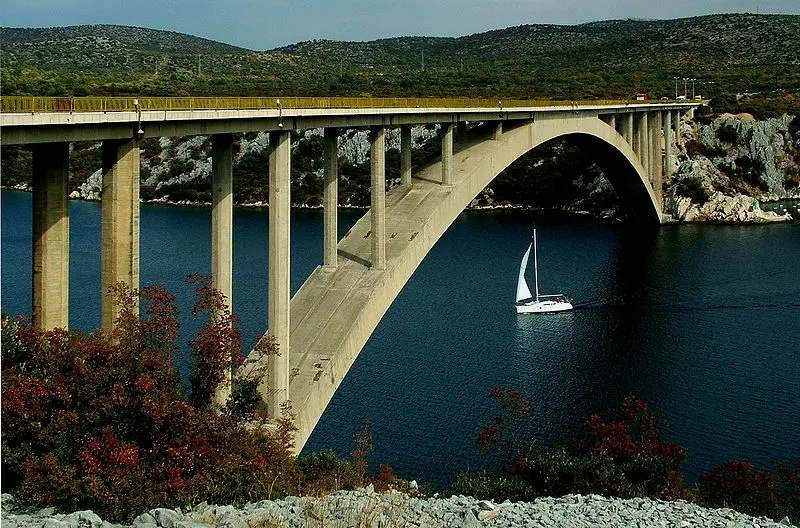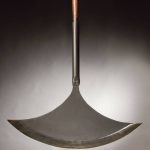As Morski/Ivo Glavas writes, when the Sibenik bridge was inaugurated on July the 27th, 1966, spanning 246 metres, it was one of the five longest arch concrete bridges in the whole world. However, only one such bridge in northern Sweden was built before the end of World War II in 1943, and the remaining three bridges only a year to two before the Sibenik bridge came to be. Unlike the Swedish one, which saw the tragic deaths of 18 workers and was being built for almost six years, the Sibenik bridge was built without any human casualties in less than three years, writes local portal SibenikIN.
The Sibenik bridge was the first in the world to be completely built with a revolutionary cantilever construction technique
Although not the longest, Sibenik bridge is the most famous of all arch concrete bridges in the world, having been built with the so-called cantilever procedure, then a completely new technique of building arch bridges. Since way back during Roman times, arch bridges have traditionally been built by placing wooden scaffolding under the bridges themselves. With the increasing spans of bridge arches, the scaffolding beneath them became increasingly complex, so their design was a serious engineering task.
Such complex scaffolding had to be well supported on the ground under the bridge. The problem occurred when you had to construct a bridge somewhere and you couldn’t lean on the ground below it. In addition, wooden arch scaffolding was very dangerous and often collapsed, with catastrophic consequences and the terrible loss of multiple human lives.
A terrible storm at the end of May 1962 destroyed the scaffolding of the Pjenavac bridge in the Moraca valley in neighbouring Montenegro, which caused the tragic deaths of as many as 25 workers. Out of a sense of deep guilt, the chief engineer took his own life shortly after.
When the great French engineer and bridge builder Eugene Freyssinet set out back in 1951 to build three arched concrete bridges on the Caracas-La Guaira motorway in Venezuela, he was aware of all the problems that came with scaffolding. He solved them with a revolutionary cantilever construction process, meaning he only needed a classic wooden scaffolding for the central part of the bridge. Until he applied the cantilever method, Freyssinet also had serious problems building bridges. After a storm in 1922, the wooden scaffolding of the bridge over the Seine near Saint-Pierre du Vauvray in France collapsed. Following Freyssinet’s idea, but improving his work, the builders of the Sibenik bridge constructed it in its entirity it in a cantilever manner without needing any support on the ground.
Eugene Freyssinet is an engineer celebrated in France and around the world, he built bridges in France, across the rest of Europe, but also in the Americas. He was a pioneer in the use of prestressed concrete to solve the problems of large-scale concrete structures, such as bridges. In addition to bridges, he was also known for building large concrete halls to accommodate aircraft at several French airports. Freyssinet was not, of course, the inventor of these new, revolutionary construction techniques but was best known for applying new technologies.
The builders of the Sibenik bridge, Ilija Stojadinovic and Stanko Sram, have sadly been almost forgotten
French builder Eugene Freyssinet is a common name when it comes to bridge construction around the world. This is usually the case when you are a member of a great European and global nation. The architects and builders of the Sibenik bridge on the other hand, are almost unknown because they came from the then socialist Yugoslavia, a country completely closed off to the West at the time.
The Sibenik bridge was designed by a Serb, an engineer from Belgrade, Ilija Stojadinovic, and the construction was led by a Croatian engineer, Stanko Sram. The Stojadinovic-Sram team designed and built the most important Croatian arch concrete bridges, including the Pag bridge. Shortly after the construction of the Krk bridge, in 1982, Stanko Sram became a full professor at the Faculty of Civil Engineering at the University of Zagreb. During that same year, Ilija Stojadinovic died, and he has no street, square or bridge in Serbia named after him. Probably because he ”bridged” Croatia, and not his homeland. That is why Stanko Sram dedicated a major book on building bridges to his colleague and friend Ilija, published back in 2002 in Zagreb.
Professor Stanko Sram built a large number of bridges in the then socialist Yugoslavia. In addition to those already mentioned, it is enough to list just a few more: the Freedom Bridge (Most slobode) and the Jankomir Bridge in Zagreb, the old Maslenica Bridge and the pedestrian bridge in Zadar. After a severe tragedy on the construction site of the Pjenavac bridge in Montenegro, Stanko Sram took over the construction. Instead of using dangerous scaffolding, he built the bridge using safer steel scaffolding. Sram then worked for a Yugoslav company called Mostogradnja, which specialised in building bridges.
Could the Sibenik bridge become a Croatian cultural monument?
Sibenik boasts a lot of truly unique items, already having two cultural monuments on the deeply desired UNESCO list. Sibenik’s historic core with all of its ancient fortresses could have been on that list, but that’s a different (and a very long) story. As we’ve seen, the Sibenik bridge is also unique, but is that a sufficient criterion for a building to become a cultural monument in Croatia?
When we think of cultural monuments, we usually think of objects or things that are more than a hundred years old, with the period of the Austro-Hungarian Monarchy as the typical general border. However, many buildings built after the First and Second World Wars also have great architectural values. Not only architectural but also urban because without these buildings, Sibenik as it is today is unthinkable. Whether or not the Sibenik bridge could join this ancient Dalmatian city’s long list of such treasures is certainly something worthy of a debate.
For more, check out Made in Croatia.










